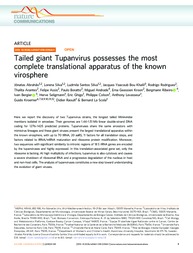Tailed giant Tupanvirus possesses the most complete translational apparatus of the known virosphere.
Tailed giant Tupanvirus possesses the most complete translational apparatus of the known virosphere.
Author(s): ABRAHÃO, J.; SILVA, L.; SILVA, L. S.; KHALIL, J. Y. B; RODRIGUES, R.; ARANTES, T.; ASSIS, F.; BORATTO, P.; ANDRADE, M.; KROON, E. G.; RIBEIRO, B.; BERGIER, I.; SELIGMANN, H.; GHIGO, E.; COLSON, P.; LEVASSEUR, A.; KROEMER, G.; RAOULT, D.; LA SCOLA, B.
Summary: Here we report the discovery of two Tupanvirus strains, the longest tailed Mimiviridae members isolated in amoebae. Their genomes are 1.44?1.51 Mb linear double-strand DNA coding for 1276?1425 predicted proteins. Tupanviruses share the same ancestors with mimivirus lineages and these giant viruses present the largest translational apparatus within the known virosphere, with up to 70 tRNA, 20 aaRS, 11 factors for all translation steps, and factors related to tRNA/mRNA maturation and ribosome protein modification. Moreover, two sequences with significant similarity to intronic regions of 18 S rRNA genes are encoded by the tupanviruses and highly expressed. In this translation-associated gene set, only the ribosome is lacking. At high multiplicity of infections, tupanvirus is also cytotoxic and causes a severe shutdown of ribosomal RNA and a progressive degradation of the nucleus in host and non-host cells. The analysis of tupanviruses constitutes a new step toward understanding the evolution of giant viruses.
Publication year: 2018
Types of publication: Journal article
Unit: Embrapa Pantanal
Observation
Some of Embrapa's publications are published as ePub files. To read them, use or download one of the following free software options to your computer or mobile device. Android: Google Play Books; IOS: iBooks; Windows and Linux: Calibre.
Access other publications
Access the Agricultural Research Database (BDPA) to consult Embrapa's full library collection and records.
Visit Embrapa Bookstore to purchase books and other publications sold by Embrapa.

